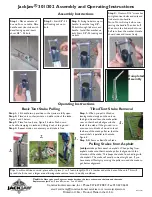
2
2
29
About the Auscultation Simulator:
The
Life
/
form
®
Auscultation Trainer
Simulator duplicates heart and lung
conditions selected by the instruc-
tor by wireless remote control. The
student must palpate to identify the
correct auscultation sites and will
hear different heart and lung sounds
as the SmartScope™ is moved from
site to site.
The simulator has six heart sites and
five lung sound sites on the anterior
surface and midaxillary sites. The
remote control can select from 12 dif-
ferent heart conditions, as well as 16
lung conditions. The instructor can
select any condition then switch to
another condition easily so the stu-
dent can compare sounds and make
a diagnosis.
The remote control does not have to
be pointed directly at the manikin or
stethoscope to operate. One remote
control will operate multiple sets of
SmartScopes™ and manikins simul-
taneously. Great for group instruction.
The range of the remote control is up
to 100 feet.
General Instructions for Use:
To begin using the Auscultation Trainer,
press the red power button. This turns
on the remote control and sends a sig-
nal to activate the stethoscope as well.
After the unit is activated, the display
will be in the “status” mode, displaying
the current menu settings for the heart
and lung conditions.
To select a new condition, press
either the heart or lung button. This
will put the display into the menu
mode. The user can select a condi-
tion by either using the number but-
tons, or by viewing the conditions
in sequence using the scroll button.
After the condition is selected press
the enter button to activate.
The remote control can be programmed
to these heart conditions:
01 Normal
02 Aortic regurgitation
03 Pulmonary stenosis
04 Mitral stenosis
05 Holosystolic
06 Mid-systolic
07 S3 Gallop
08 S4 Gallop
09 Systolic click
10 Atrial septal defect
11 PDA
12 VSD
The remote control can be programmed
to these lung conditions:
01 Normal Lung
02 Normal Vesicular
03 Wheezes
04 Mono wheeze
05 Fine crackle
06 Coarse crackle
07 Ronchi crackle
08 Stridor
09 Cavernous
10 Bronchovesicular
11 Bronchial
12 Pulmonary edema
13 Infant
14 Friction rub
15 Egophony
16 Pectoriloquy
Consult the enclosed laminated
card for lung and heart sound site
locations.
To listen to the selected sounds,
place the earpieces in ears angled
in a forward position. Place the dia-
phragm of the SmartScope™over one
of the appropriate sites on the mani-
kin (see diagram on back).
As an alternative, an amplified speaker
(SB20146U) can be used allowing an
entire classroom to hear at the same
time. To connect the speaker, plug
the speaker cord into the speaker
jack on the top of the Smart Scope™
box. When a speaker is connected to
the SmartScope™, the ear pieces will
not work. Place the diaphragm of the
SmartScope™over the appropriate
sites on the manikin.
NOTE:
The remote has a battery saver
that shuts the unit down after 8 minutes
if the remote is left on the same set-
ting. To prevent it from shutting down,
select a different heart or lung sound
within the 8 minute period of time.
Available Supplies
LF01144U
Additional SmartScope™
LF01145U
Additional Auscultation
Manikin Torso
LF01148U
Replacement Remote
Control
SB20146U
Amplified Speaker
Procedure C










































